Have you ever wondered why some rooms in your home feel too hot or too cold, no matter how much you adjust the thermostat? The answer might lie in your ductwork. Leaky ducts can wreak havoc on your home’s comfort and energy efficiency, leaving you with uneven temperatures and skyrocketing energy bills.
When your duct system has gaps or cracks, it allows conditioned air to escape. This means your heating or cooling system has to work harder to maintain the desired temperature, leading to higher energy costs. Additionally, leaky ducts can pull in dust and allergens, compromising your indoor air quality.
But there’s a solution: proper sealing and insulation. By addressing these leaks, you can improve airflow, reduce energy waste, and create a more comfortable living environment. Whether you’re dealing with cold spots, dust buildup, or unexpected spikes in your energy bill, sealing your ductwork can make a significant difference.
In this guide, we’ll explore effective insulation techniques that can help you tackle these issues. From DIY tips to professional methods, you’ll learn how to optimize your duct system for better performance and long-term savings. Let’s dive in and take control of your home’s comfort and efficiency.
Key Takeaways
- Leaky ductwork can cause uneven temperatures and higher energy bills.
- Proper sealing improves airflow and reduces energy waste.
- Insulation helps maintain consistent temperatures throughout your home.
- Dust and allergens can enter through gaps in the duct system.
- Addressing leaks enhances indoor air quality and comfort.
- DIY methods and professional solutions are available for sealing ducts.
Understanding the Impact of Leaky Ducts on Your Home Comfort
Ever walked from one room to another and felt like you’ve entered a different season? This frustrating experience is often caused by leaky ducts. When your air duct system has gaps or cracks, it disrupts airflow, making some rooms too hot while others stay chilly.
These leaks don’t just affect your comfort—they also strain your heating and cooling system, leading to higher energy bills. By understanding the signs and effects of leaky ducts, you can take steps to improve your home’s efficiency and indoor air quality.
Common Signs of Leaky Ducts
How do you know if your ducts are leaking? Here are some telltale signs:
- Uneven temperatures: One room feels like a summer blaze, while another stays frosty.
- Whistling or rattling noises: These sounds often indicate air escaping through gaps.
- Dust buildup: Leaky ducts can pull in dust and allergens, compromising your indoor air quality.
If you notice these issues, it’s time to inspect your duct system. Simple tests, like feeling for air leaks or checking for visible gaps, can help you identify the problem.
Effects on Energy Bills
Leaky ducts force your heating and cooling system to work harder, driving up your energy bill. According to experts, up to 30% of conditioned air can escape through gaps, wasting energy and money.
This extra strain not only increases your monthly costs but also shortens the lifespan of your system. By addressing leaks, you can reduce energy waste and enjoy more consistent temperatures throughout your home.
Ready to take action? The next section will explore effective solutions to seal your ducts and restore your home’s comfort.
HVAC Duct Sealing Guide: A Comprehensive Look at Insulation Techniques
Ever felt like your home’s energy bills are out of control, even when you’re not using much heating or cooling? The culprit might be your ductwork. Proper insulation and sealing can make a world of difference, improving comfort and saving you money.
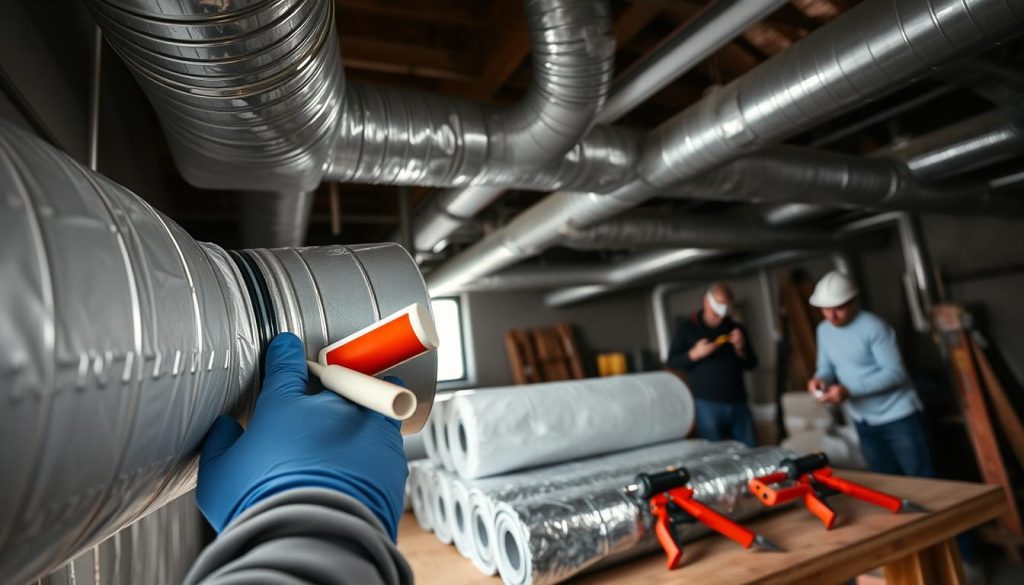
When it comes to sealing leaks, not all methods are created equal. Experts often recommend using mastic over tape for its durability. Mastic is a water-based putty that adheres well to surfaces, ensuring a long-lasting seal. On the other hand, tape can fail over time due to temperature changes and condensation.
Expert Recommendations Over Coffee
Imagine sitting down with a cup of coffee and chatting with an expert about your ductwork. They’d likely tell you that addressing leaks is one of the most cost-effective ways to improve your home’s energy efficiency. Here’s what they might suggest:
- Inspect your ducts: Look for visible gaps or feel for air leaks. Even small cracks can lead to significant energy loss.
- Choose the right sealant: Mastic is ideal for larger gaps, while tape works for smaller ones. For gaps over ¼ inch, combine mastic with fiberglass mesh tape.
- Consider professional help: For older or hard-to-reach ducts, hiring a pro can ensure a thorough job.
These steps not only reduce energy waste but also improve indoor air quality by preventing dust and allergens from entering your home.
DIY vs. Professional Approaches
If you’re a hands-on homeowner, DIY sealing can be a great option. It’s cost-effective and allows you to tackle minor leaks yourself. However, for larger or more complex issues, professional services might be worth the investment. Pros use advanced tools like Aeroseal technology, which can measure and seal leaks with precision.
| Method | Pros | Cons |
|---|---|---|
| Mastic | Durable, long-lasting, ideal for larger gaps | Messy application, requires drying time |
| Tape | Easy to apply, good for small leaks | Can fail over time, less durable |
| Professional Services | Thorough, uses advanced technology | Higher cost, requires scheduling |
Whether you choose DIY or professional sealing, the key is to act now. Addressing leaks can save you up to 20% on your energy bills and create a more comfortable living environment.
DIY Versus Professional Solutions for Sealing Your Ductwork
Are you tired of uneven temperatures and high energy bills in your home? The problem might lie in your air ducts. Whether you’re a hands-on DIY enthusiast or prefer to leave it to the pros, there are effective ways to address leaks and improve your home’s efficiency.
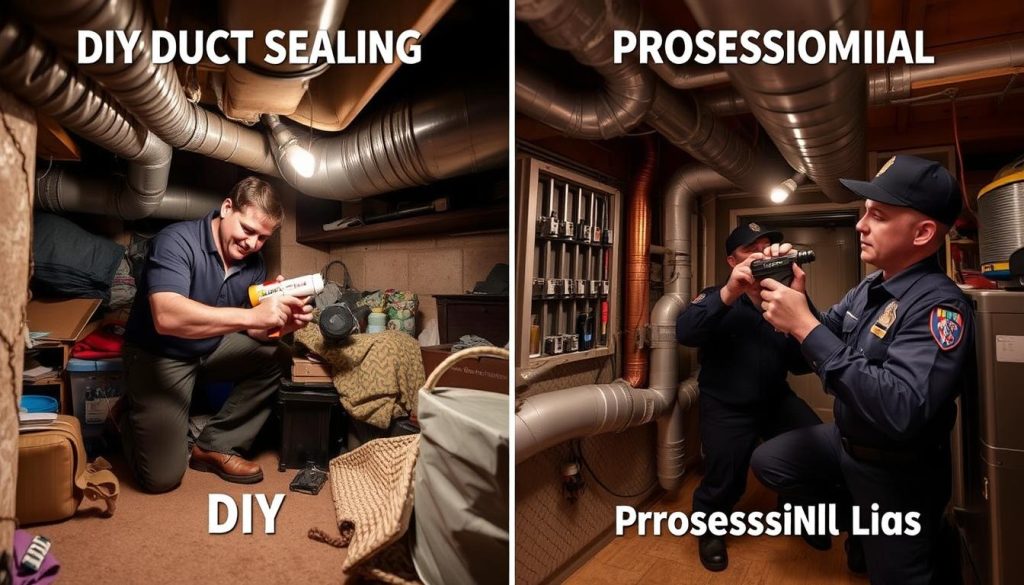
DIY Duct Sealing Methods
If you enjoy tackling home projects, sealing your ductwork yourself can be a cost-effective option. Start by inspecting your system for visible gaps or leaks. Use your hands to feel for escaping air or listen for whistling noises.
For small cracks, specialized tapes designed for ducts can work well. However, for larger gaps, mastic is the go-to choice. This water-based putty adheres firmly and lasts longer than tape, especially in areas with temperature changes.
Here’s a quick guide to DIY sealing:
- Clean the area around the leak to ensure proper adhesion.
- Apply mastic with a brush or your fingers for larger gaps.
- Use fiberglass mesh tape for added durability in high-stress areas.
While DIY methods are effective for accessible leaks, hidden or hard-to-reach areas might still cause problems. That’s where professional services come in.
Benefits of Professional Services
Think of professional duct sealing like patching potholes on a busy highway—it’s thorough and efficient. Experts use advanced tools like Aeroseal technology to detect and seal leaks you can’t see. This method ensures every gap is addressed, even in tight spaces.
Here’s why hiring a pro might be worth it:
- Comprehensive inspection: Professionals use diagnostic tools to identify all leaks.
- Durability: Their methods often last longer than DIY fixes.
- Time-saving: You won’t have to spend hours crawling through your attic or basement.
While professional services cost more upfront, they can save you money in the long run by reducing energy waste and improving your system’s lifespan.
Whether you choose DIY or professional sealing, the key is to act now. Addressing leaks can improve your home’s air quality, lower your energy bills, and create a more comfortable living environment. Assess your options based on your budget, urgency, and technical comfort level.
Enhancing Energy Efficiency and Indoor Air Quality
Did you know that sealing your home’s ductwork can save you hundreds of dollars annually? Small leaks in your system might seem insignificant, but they can lead to big energy losses. Addressing these issues not only lowers your energy bill but also improves your home’s comfort and air quality.
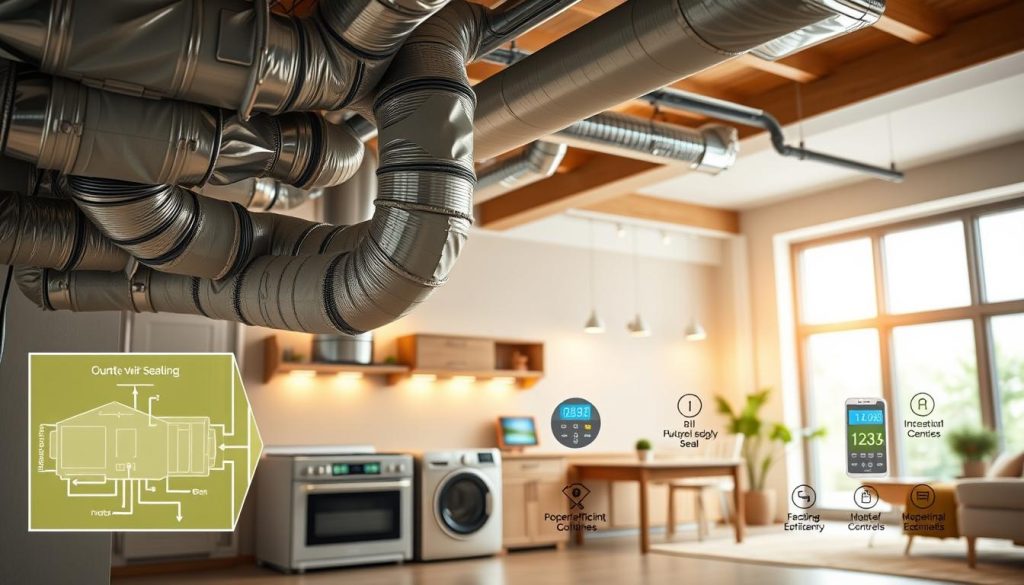
Lowering Utility Costs
Leaky ducts can waste up to 30% of your heating and cooling energy. That’s like throwing money out the window every month. By sealing these gaps, you can reduce your energy consumption and see significant savings on your utility bills. Experts estimate that proper sealing can cut costs by up to 20%.
Think of it as patching holes in a bucket—your system won’t have to work as hard to maintain the desired temperature. This not only saves money but also extends the life of your heating and cooling equipment.
Improving Air Quality for Your Home
Sealing your ductwork does more than just save energy—it also enhances your indoor air quality. Leaks can pull in dust, allergens, and even mold spores from attics or crawl spaces. This can aggravate allergies and respiratory issues, making your home less comfortable.
By addressing these leaks, you create a cleaner, healthier environment. Properly sealed ducts ensure that the air circulating in your home is free from contaminants, giving you peace of mind and better overall comfort.
Ready to take the next step? In the following section, we’ll walk you through a detailed, step-by-step guide to sealing your ducts effectively. Your home—and your wallet—will thank you.
Step-by-Step Process to Seal Your Ducts Effectively
Ready to tackle those pesky air leaks in your home? Sealing your ductwork doesn’t have to be overwhelming. With the right tools and a bit of patience, you can improve your home’s efficiency and comfort. Let’s break it down into simple, manageable steps.
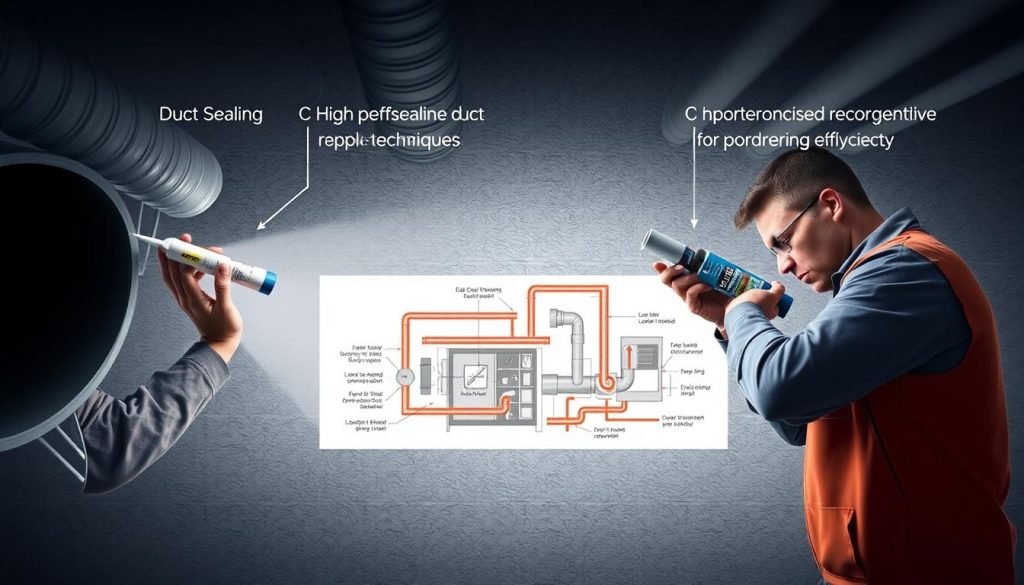
Preparing Your Workspace
Before you start, it’s essential to set up your workspace for success. Think of it like prepping a kitchen before baking—everything should be clean and organized. Here’s how to get started:
- Clear the area: Remove any clutter around your duct system to ensure easy access.
- Safety first: Wear gloves, safety goggles, and a mask to protect yourself from dust and debris.
- Ventilate the space: Open windows or use a fan to keep the area well-ventilated while working.
Identifying and Marking Leaks
Finding leaks is like solving a mystery—you need the right tools and a keen eye. Here’s how to spot those sneaky gaps:
- Use a smoke pencil: Lightly pass it near the ducts; if the smoke wavers, you’ve found a leak.
- Feel for air: Run your hand along the seams to detect escaping air.
- Mark the spots: Use chalk or a marker to highlight where you need to apply sealant.
Applying Sealant Techniques
Now comes the fun part—sealing the leaks. Think of it as carefully frosting a cake; precision is key. Here’s how to do it right:
- Clean the area: Wipe down the marked spots to ensure the sealant adheres properly.
- Apply mastic: Use a brush or your fingers to spread it evenly over larger gaps. For smaller cracks, foil tape works well.
- Let it dry: Allow the sealant to cure completely before testing your system.
By following these steps, you’ll create a more efficient air system, reduce energy waste, and enjoy consistent temperatures throughout your home. It’s a small effort with big rewards!
Long-Term Maintenance and Inspection of Sealed Ductwork
Keeping your home comfortable and energy-efficient doesn’t end with sealing your ductwork. To ensure your system performs at its best, regular maintenance and inspections are essential. Think of it as giving your home a little TLC to keep everything running smoothly.
Routine Inspection and Upkeep
Regular checks help catch small issues before they become big problems. Start by inspecting your ductwork for visible damage like dents or loose connections. Even minor gaps can lead to energy loss over time.
Here are some simple steps to keep your system in top shape:
- Clean air filters: Replace or clean them every 1-3 months to prevent dust buildup and maintain airflow.
- Check for leaks: Use a smoke pencil or your hand to feel for escaping air. Address any gaps promptly.
- Monitor energy bills: A sudden spike could indicate a leak or inefficiency in your system.
These small tasks can make a big difference in your home’s comfort and efficiency.
Professional Inspections and Their Benefits
While DIY checks are helpful, professional inspections ensure a thorough evaluation. Experts use tools like blower testers to measure duct performance and identify hidden issues. Scheduling a pro inspection every 2-3 years can extend the life of your system and save you money in the long run.
Professionals also ensure your seal remains intact, preventing energy waste and maintaining consistent temperatures throughout your home. It’s a small investment for peace of mind and long-term savings.
By staying proactive with maintenance, you’ll enjoy a more efficient system, lower energy bills, and better indoor air quality. Your home—and your wallet—will thank you!
Current Industry Trends and Research in HVAC Technology
What if your home could stay comfortable while saving you money? The latest advancements in HVAC technology are making this possible. From innovative sealing methods to data-driven solutions, the industry is evolving to improve efficiency and reduce costs.
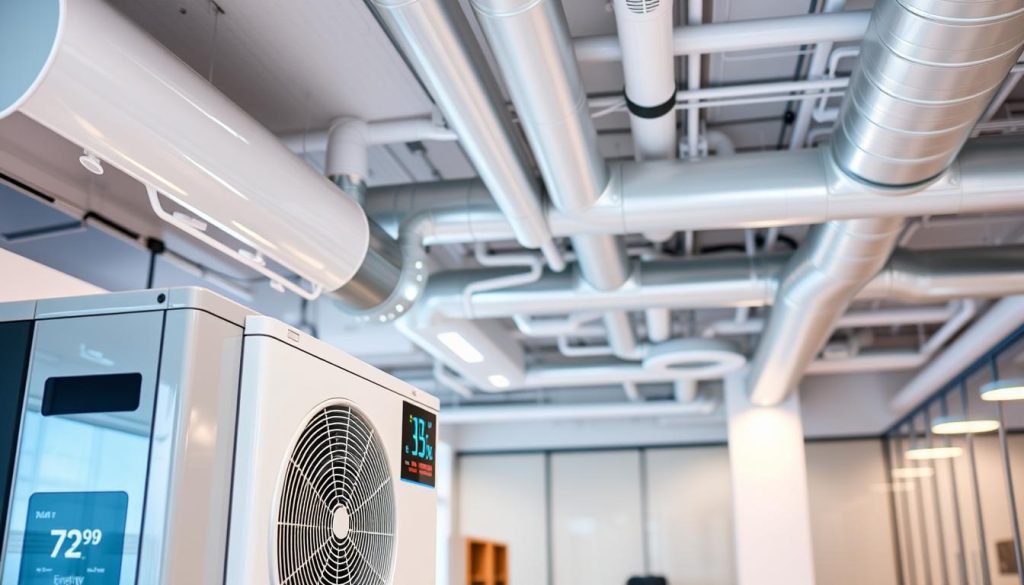
Innovative Sealing Technologies
One of the most exciting breakthroughs is Aeroseal, a technology endorsed by the U.S. Department of Energy. Unlike traditional methods, Aeroseal uses computer analysis to identify and seal hidden leaks in your ductwork. This ensures a more thorough fix, reducing energy waste and improving indoor air quality.
Another game-changer is advanced sealant products and tapes. These materials are designed to withstand temperature changes and last longer than older options. For example, fiberglass mesh tape combined with mastic creates a durable seal that prevents future leaks.
Data-Driven Energy Efficiency
Data is transforming how we approach energy efficiency. Smart thermostats and IoT-enabled systems now provide real-time insights into your home’s heating and cooling patterns. These tools can identify inefficiencies and suggest adjustments to save energy.
For instance, predictive maintenance uses data to detect potential issues before they become costly problems. This not only reduces downtime but also extends the lifespan of your system. By adopting these technologies, homeowners can lower their energy bills and enjoy a more comfortable living environment.
| Technology | Benefits | Limitations |
|---|---|---|
| Aeroseal | Seals hidden leaks, improves efficiency | Requires professional installation |
| Advanced Sealants | Durable, long-lasting | Messy application |
| Smart Thermostats | Real-time data, energy savings | Initial cost |
Staying updated with these trends can help you make informed decisions about your home’s heating and cooling needs. Whether you’re looking to cut costs or improve comfort, the future of HVAC technology has something to offer.
Building Trust with Expert Insights and Personal Experiences
Imagine waking up to a perfectly balanced temperature in every room of your home. Sounds like a dream, right? For many homeowners, this reality became possible after addressing leaky ducts. Let’s dive into some real-life stories and expert insights to show you how sealing your air system can transform your living space.
Real-Life Transformations
Take Sarah, for example. She struggled with uneven temperatures in her home for years. One room felt like a sauna, while another stayed chilly. After consulting an expert, she discovered her air ducts were riddled with leaks. Using mastic and fiberglass mesh tape, she sealed the gaps. The result? Consistent comfort and a 20% drop in her energy bill.
Another homeowner, Mike, noticed dust constantly settling on his furniture. He learned that his ductwork was pulling in allergens from the attic. After sealing the leaks, his indoor air quality improved dramatically, and his family’s allergies subsided.
Expert Credentials You Can Trust
When it comes to sealing your air system, it’s essential to rely on proven methods. Aeroseal, a technology endorsed by the U.S. Department of Energy, is a game-changer. It uses computer analysis to detect and seal hidden leaks, ensuring a thorough fix. Experts recommend it for its precision and long-lasting results.
Here’s what professionals suggest for maintaining your system:
- Inspect regularly: Check for visible gaps or feel for escaping air.
- Use quality materials: Mastic and fiberglass mesh tape are durable options.
- Consider professional help: For hard-to-reach areas, experts ensure a comprehensive job.
By combining DIY efforts with professional expertise, you can achieve a more efficient and comfortable home. Whether it’s reducing energy costs or improving air quality, sealing your ducts is a solution worth considering.
Conclusion
Your home’s comfort and energy efficiency are just a few steps away. By addressing leaks in your air system, you can save up to 20% on your energy bill while enjoying consistent temperatures in every room. Improved indoor air quality is another benefit, as sealed ducts prevent dust and allergens from entering your living space.
Start by inspecting your system for gaps and applying durable materials like mastic or fiberglass mesh tape. Regular maintenance ensures long-term performance, so schedule inspections every few years to keep everything in top shape.
Whether you tackle this project yourself or hire a professional, the results are worth it. A well-sealed system not only reduces energy waste but also enhances your home’s overall comfort. Take action today and experience the difference a properly sealed air system can make.
FAQ
What are the common signs of leaky ducts in my home?
How do leaky ducts affect my energy bill?
What are some DIY methods for sealing ductwork?
Why should I consider professional duct sealing services?
How does sealing ducts improve indoor air quality?
What steps should I take to prepare for duct sealing?
How often should I inspect my sealed ductwork?
Are there new technologies for duct sealing?
Can sealing ducts really lower my utility costs?
Source Links
- How to Insulate HVAC Ductwork
- A Beginner’s Guide to Duct Sealing
- Your Ultimate Guide to Duct Sealing
- How Leaky Ducts Affect Your HVAC System’s Efficiency | Wright AC Services
- AC Duct Leakage: Uncovering Hidden Problems in HVAC System
- Duct Sealing Methods: 3 Solutions for Sealing Your Ductwork
- The Ultimate Guide to Sealing Ducts: A Comprehensive Overview
- How to Insulate HVAC Ductwork: A Comprehensive Guide – Today’s Homeowner
- How to Seal Air Ducts – A DIY Guide
- A COMPLETE GUIDE TO PROPER DUCT SEALING | Anton’s Plumbing, Heating, Cooling, And Energy Experts
- Air Sealing Your Home
- Air Sealing Techniques to Boost Home Comfort & Efficiency
- How to Seal Ductwork in Your Attic: A Guide
- A Homeowners Guide to Ductwork Sealing – TLS Insulation
- How To Fix Leaks in Air Ducts
- Duct Inspection and Sealing | CABS Heating & Air Conditioning
- What Is Air Duct Sealing? 2024 Homeowners Guide | Air & Energy of NWFL
- What Is Air Duct Sealing?
- Top 10 HVAC Industry Trends in 2025 | StartUs Insights
- HVAC Industry Trends You Need To Know in 2024 | SBE
- HVAC Technology Trends | Future of HVAC | Motili
- HVAC System Installation Challenges
- Signs You Need HVAC Ductwork Replacement – Skylands Energy
- Duct Sealing | The Cooling Company
- HVAC Duct Sealant: Your Ultimate Guide to the Best Choices
- How To Seal Air Ducts Like Professionals – Complete Guide – MMI Blog

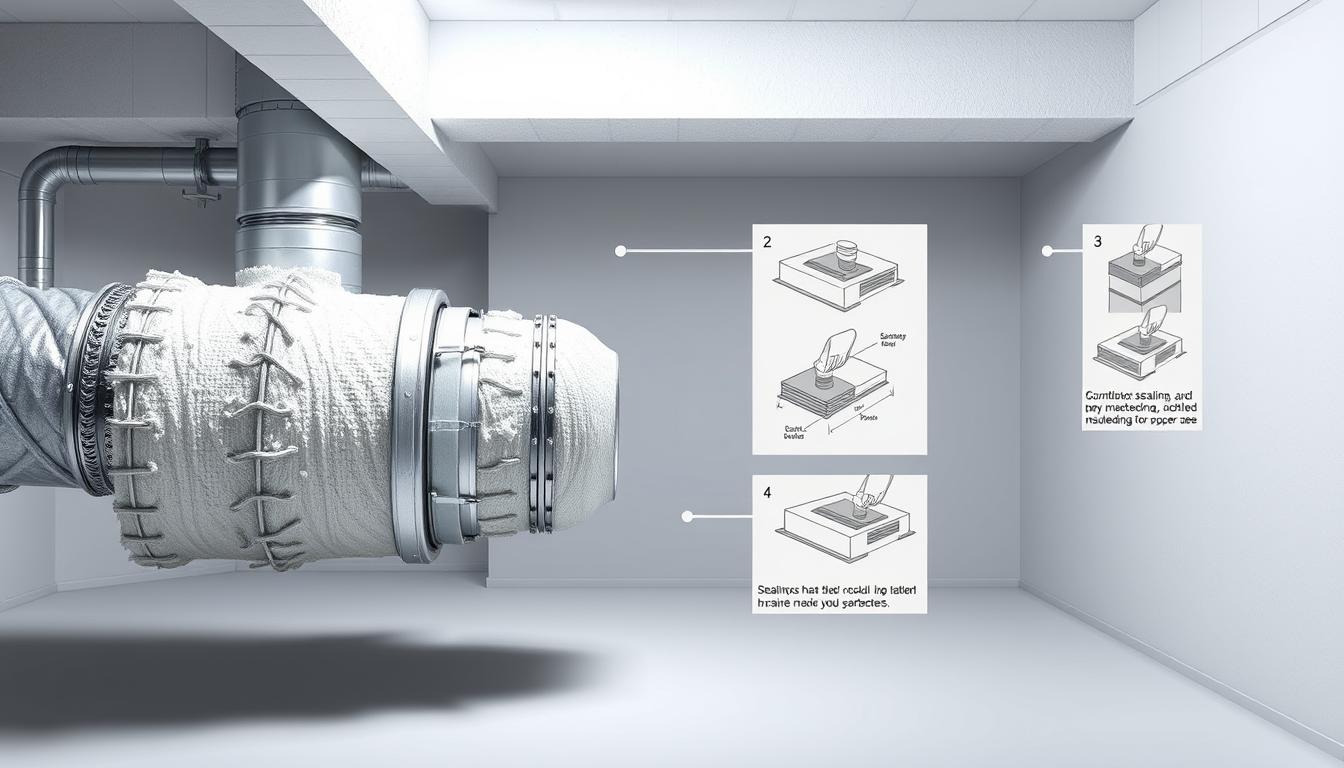


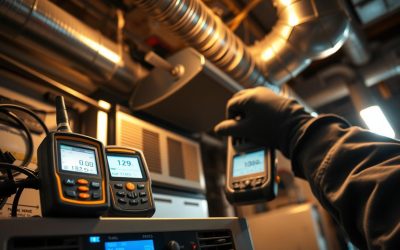
0 Comments